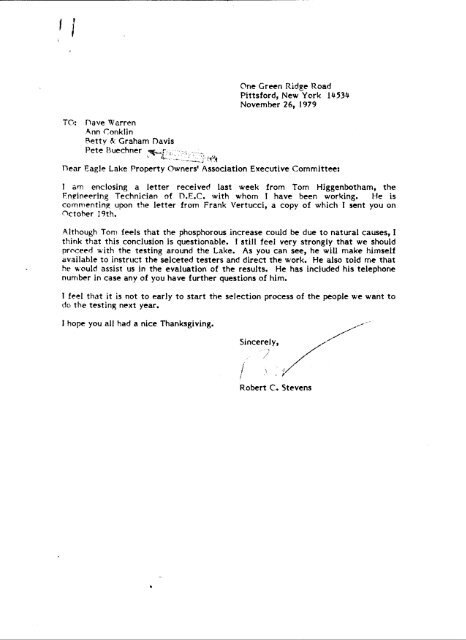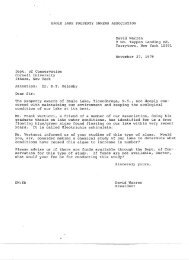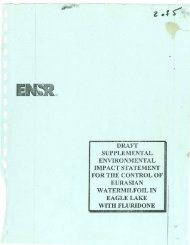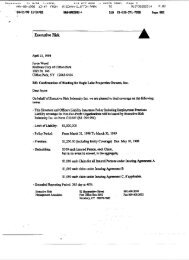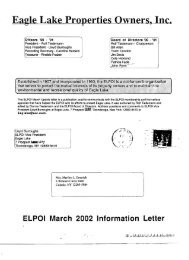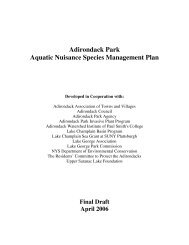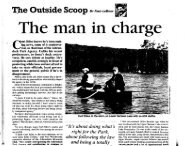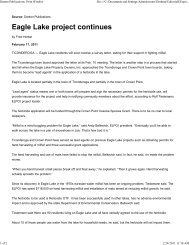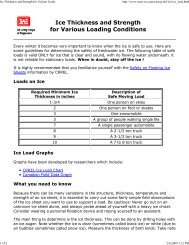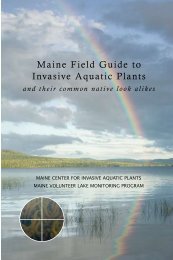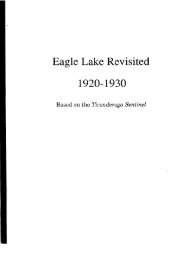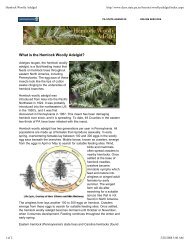11-26-1979 - Eagle Lake Property Owner's Inc.
11-26-1979 - Eagle Lake Property Owner's Inc.
11-26-1979 - Eagle Lake Property Owner's Inc.
Create successful ePaper yourself
Turn your PDF publications into a flip-book with our unique Google optimized e-Paper software.
I<br />
TO:<br />
nave Warren<br />
i~nn c.:onkJin<br />
p.etty IX Graham Davis<br />
Pete Buechner ,~ ..... £:!:' .... / ' .-:-"<br />
'J<br />
• 'n "--~-:"'J "'I;.~<br />
One Green Ridge Road<br />
Pittsford, New York 14534<br />
November <strong>26</strong>, <strong>1979</strong><br />
near <strong>Eagle</strong> <strong>Lake</strong> <strong>Property</strong> Owners' Association Executive Committee:<br />
I am enclosing a letter received last week from Tom Hjggenbotham, the<br />
Fn~ine("ring Technician of D.E.C. with whom I have been working. He is<br />
commenting upon the letter from Frank Vertucci, a copy of which I sent you on<br />
0ctoher 19th.<br />
Although Tom feels that the phosphorous increase could be due to natural causes, I<br />
think that this conclusion is questionable. I still feel very strongly that we should<br />
pr
New York State Department of Environmental Conservation<br />
Ray Brook, NY 12977<br />
X RO(teX~~X~$',<br />
Commissioner<br />
Robert F. Flacke<br />
Mr. Robert C. Stevens<br />
One Green Ridge Road<br />
Pittsford, NY 14534<br />
RE:<br />
November 15, <strong>1979</strong><br />
Algae Problem, <strong>Eagle</strong> <strong>Lake</strong>, Ticonderoga and Crown Point (T), Essex (Co)<br />
Dear Mr. Stevens:<br />
I am sorry it took so long to answer your letter of October 19, <strong>1979</strong>; we<br />
were very busy this past summer and <strong>11</strong>m just beginning to catch up.<br />
We were able to identify the algae in question down to the genus level, (i.e.,<br />
Family Rivulanaceae, Order Nostocales, Phylum Cyanophyta, Genus Gleotrichia).<br />
As you can see from the enclosed literature there is some question as to the<br />
species, however, I believe this is an irrelevant point. The different species<br />
1nvolved exhibit very similar physiological characteristics and the separation<br />
of species is, in my opinion, an academic discussion. While we seem to both<br />
be on similar tracks concerning this algae, I cannot agree that it is a IIgood ll<br />
algae. In fact, it has been mY experience that no blue-green, i.e., Cyanophyta,<br />
al gae are "good ll •<br />
G1eotrichia generally require high levels of total phosphorus and because of the<br />
low population density around <strong>Eagle</strong> <strong>Lake</strong> mY initial "guess" would be that the<br />
influx of total phosphorus is from natural sources, e.g., surface storm water<br />
runoff. However, this should be determined before any conclusions are reached.<br />
The ban on phosphates in detergents in New York has been very effective and<br />
unless detergents are being brought in from elsewhere I would disregard this<br />
as a source of the nutrient enrichment which seems to be occurring.<br />
As a first step in determining the cause and extent of the prob1em,a sanitary<br />
survey should be initiated as early in the spring of 1980 as is possible. As<br />
I have previously stated,I can make myself available to the lake association<br />
for training of their personnel and direction of the survey. Due to the lack<br />
of manpower in DEC the burden of actually performing the necessary work would<br />
fallon the lake association.<br />
With regards to your questions about the nature of phosphates, simply speaking,<br />
phosphates will settle into the sediments of a lake and remain trapped there<br />
as long as there are concentrations of dissolved oxygen at the sediment/water<br />
interface. This can be determined rather easily next summer. There is a strong<br />
possibility that phosphates will be recycled into the water column during spring<br />
•<br />
-'
...<br />
Page 2<br />
Robert C. Stevens<br />
November 15, <strong>1979</strong><br />
and fall turnover, that is, when a change in temperature of the lake causes<br />
the warmer, bottom layer of water to rise to the surface stirring up the<br />
sediments. In short, we are not dealing with a mobile compound. I am enclosing<br />
some information which should help and if we can get together this<br />
spring to begin training any volunteers from the association, I will be able<br />
to explain the phosphate phenomena more specifically. In the meantime, if<br />
you have any questions, please call me at (518) 891-1370.<br />
I look forward to meeting with you next year.<br />
RJM :TH: 1 al<br />
Enclosures<br />
By:<br />
Sincerely,<br />
Have a good winter.<br />
Richard J. McCormick, P. E.<br />
Senior Sanitary Engineer<br />
~<br />
c\C/YV)<br />
Thomas Higginbotham<br />
Engineering Technician<br />
•
· :'1TE1\ ALGAE<br />
.,
256 1I0W TO KNOW TIlE FHESI\WATEH ALGAE<br />
waler buff-colored. \VIH'II alJUII(hnt along hathing heaches t!!.~s<br />
\ant causes a SeV(TC skin irritation among some pcrsom w~il'h<br />
laS )('en mistakcn for S\\,lmllllT S . 1. ¥. 7J(/iii7i:""TnNT\V:')1'Gi)~S<br />
a so air y common. t )egins de\'e1op~~~'nt as an attached thallus<br />
but later appears at the surface in hrown, gelatinous and amorphous<br />
masses, either expanded and flat or somewhat globular. G.<br />
Pisum Lag. forms hard, green or black balls, 1 or 2 mm. in<br />
diameter on submersed vegetation, sometimes completely covering<br />
the host plant. Nine species have been reported from the<br />
United States.<br />
592b Spores abscnt; trichomes embedded in hard mucilage to<br />
form globular thalli which may coalesce; thus producing a<br />
continuous, lumpy stratum; trichomes radiate, or more often<br />
densely compacted and ncarly parallel. Fig. 429 ......................<br />
............................................................................_................. Rivularia<br />
F,g. 0429. Rivu/aria sp. (a) diaeram<br />
of porl,on of attached colony<br />
10 show arrongement of filamenls;<br />
(b) one f,lament showing basal<br />
helerocysls.<br />
This genus may be differentiated<br />
from Gloeotricllia (Fig. 428) by its<br />
lack of akinetes at the base of the<br />
trichome, by thc compact (almost<br />
parallel arrangement of the trichomes)<br />
and by the extreme firmness<br />
of the colonial mucilage. All<br />
species arc attached, mostly to logs<br />
and stones in the water, sometimes<br />
fanning extensive, pebbled patches.<br />
Some large colonies show a 'zonation'<br />
[('suIting from slIccessive generations<br />
of false branches. Twentvfour<br />
species ha\'(' l)('en report~d<br />
from the United States but many of<br />
the names seem to be confused<br />
with Gloeotricllia.<br />
/1m<br />
III<br />
Irich,<br />
.1 lo~<br />
ill~ ~<br />
prodl<br />
~ro\\'<br />
allall<br />
Tlw<br />
hy si;<br />
Jail' )<br />
of nJ<br />
bran(<br />
iJy f<br />
misC(<br />
laell!'<br />
!lpeci,<br />
arc "<br />
593b<br />
594a<br />
Thi<br />
in wi<br />
rC~1I<strong>11</strong>'<br />
an' a<br />
"a~al<br />
~(llital<br />
Plallb<br />
4·16) I<br />
lIl'dd,<br />
~p.'dCl<br />
})I'('II j<br />
Nali~<br />
1<br />
593a (590) Filaments frecly branchcd, thc branches usually lyin~<br />
several within thc shcath of the main filamcnt for some<br />
distance, thcn diverging, Fig. 430 ............................... Dichothrix
,\<br />
103<br />
"" Flabalill',<br />
't!I'IIIl~. Tile<br />
,III <strong>11</strong>. lUlllillo<br />
I ('I'S.<br />
I are small<br />
I diameter)<br />
('I' surfaces<br />
<strong>11</strong> vicwC'd in<br />
I' cOllcC'nt ric<br />
hc filamcn t s<br />
lIehcd, and<br />
he ~Ij(':l t hs<br />
liek, hyaline<br />
wi t hone<br />
pheric31 or<br />
(If hormo<br />
('II(f:.; of the<br />
d:lins about<br />
'''phrrical in<br />
I'nish wall.<br />
erc31ary or<br />
I'OWS on sullo.<br />
,lIl1sks, or on<br />
:Jlld possihly<br />
Ilt illclude it<br />
}·'IS IS of a<br />
or hollow.<br />
ughout its<br />
I ill!!:. The<br />
, :llId with<br />
lIuling the<br />
(If the trio.<br />
I or barrel<br />
y they are<br />
I' f:lIllily in<br />
1,(' of ~ufIi<br />
I is not of<br />
L, IS78.<br />
sufiicif'nt illiportancf', ho\\,p\'f'r, to ju"lify thp (';;1:lhli"hllll'nt of a di"tillct<br />
family, as has i>C'en proposC'd by ccrt ain phycolugist S.I<br />
N. 1()IJlltll,~ \r""d (Fig. (2), th!' only J\lllcriean SI)('ci!'s, hns ]."!'II fOlllld in<br />
sc,"cral ()f titp EllstpfI1 stntes. It is generally found growing on st"II(,S in more or<br />
less rapid wat.er of brooks.<br />
A<br />
• ; ..... .'" ..... • t<br />
.. !'<br />
B<br />
FJ
!<br />
I I<br />
. I<br />
; I<br />
104 FRESII-WATEU AU;AE OF THE UNITED STATES<br />
SOlllet imes bot.h ends of the horlllogone become attenuated, and the young<br />
t richollle breaks transversely int () two parts at a plane where two adjoining<br />
heterocysts have been formed in its median portion.<br />
Some of the genera which regularly form heterocysts also form akinetes;<br />
others lack akinetes. Akinetes arc generally formed singly and<br />
next the basal heterocysts. They are much longer and somewhat broader<br />
than the vegetative cells.<br />
Genera of the Rivulariaceae found in the United States differ as<br />
follows:<br />
Heterocysts lacking:<br />
Tril'homes with pointed enlls pnralll'l. ............ " ............ 1. Amphithrix<br />
Trichonll's with pointed ends not paralleL .............. '" .. 2. Calothrix (p.p.)<br />
Hl'terocysts present:<br />
Filaments united into spherical or hemispherical thalli:<br />
One trichome wit.hin a shl'ath:<br />
Tri('jlOllles without akillelcs ................................. 4. Rivularia<br />
Trichome!! with akinl't!'!l. . . . . . . . . . . . . . . . . . . . . . . . . . . . . . . .. 5. Gloeotrichia<br />
Twu lb §ilveral tnchomes m a shl'ath ......................... qt!. Silec8nema~<br />
Filaments solitary or united in thalli of inddinite shape:<br />
False branching scarce or lacking, t.richomcs singh' within a I'henth ........•••.<br />
• 2. Calothrix (p.p.)<br />
False branching profuse, severn! t richonH'.8 in a common sheath .............. .<br />
3. Dichothrix<br />
1. Amphithrix Klitzing, 1843; emend. Bornet and Flahault, 1886.<br />
The trichomes of A 7nphithrix arc distromatic and consist of a lower<br />
port ion composed of densely interwoven<br />
trichomes (so closely packed t.hat they<br />
appear to be parenchymatous) and of<br />
.~ ~:, "'. . '.<br />
an upper portion with numerous erect<br />
;..' ~,.~"<br />
.<br />
trichomes at.tenuated to hairlike points<br />
n." ,<br />
~<br />
,', "<br />
FlU. G3.-Aml'hithriz janthina<br />
(Mont.) B. and F. Drawn from a<br />
herbarium specimen. (X 1300.)<br />
formed. Reproduct.ion is by<br />
formed singly or in series.<br />
This genus is includf'u in<br />
at tenuation of the branches.<br />
heterocysts.<br />
at their distal ends. The erect trichomes<br />
arc parallel to one another"<br />
Heterocysts and akinetes arc never<br />
means of hormogones, which may be<br />
the Rivulariaceae hf'cause of the marked<br />
It is exceptiunal in that it does not form<br />
A. Janthina (Mont.) n. and F. (Fi~. (i3) has been found ~rowing on stones in 8.<br />
hrook in ConnecticuV and at Williamstown, l\lassll.chusetts. According to<br />
European workers this alga grows as a thin, expanded layer and hos a purplish<br />
color.2<br />
2. Calothrix Agnrdh, 1824 [M astigonema Schwabe, 18:l7 (p.p.);<br />
M astigothrix Kutzing, 1843; 1J ollweothrix (Thuret) Kirchner, 1900).<br />
1 COLLINS, 1005. , BOItN}:T and FLAliAULT, 1886.<br />
The t richomes<br />
in a fine hairli<br />
hairlike attenlJ<br />
a few species t<br />
surrounding th<br />
ness throughO<br />
hyaline or colo<br />
the filaments <strong>11</strong><br />
tative cells tow<br />
constrictions at<br />
are ofte,n cylin<br />
structure. He<br />
Calothrix trichc<br />
lies external t<<br />
never form hel!<br />
The filamCi<br />
strata of micrl<br />
pcncilliform, pi<br />
Calothrix gen<br />
flowing or standi<br />
Certain sp
M l' XOl'lIl'CEAE-!IOUMO(;()XALES 105<br />
,lid 1 he young;<br />
" two adjoin-<br />
'0 form akin<br />
,I Rin~ly and<br />
I\'hat broader<br />
<strong>11</strong> ('8 differ as<br />
1. Arnphithrix<br />
:alothrix (p.p.)<br />
4, Rivularia<br />
, Gloeotrichia<br />
Ii. Sacconema<br />
The trichomeR of Cal()llirix lIIay t.aper from baRe to apex :lnd terminate<br />
in a fine hairlike point, or the basal porI ion may be cylindrical and the<br />
hairlike attelluation restricted to the uppcr portion of trichome. In<br />
a fcw ~pecies the attcnuation at thc distal cnd is quite abrupt. Sheaths<br />
surrounding the trichomes are generally cylindrical and of the same thickness<br />
throughout. They arc homogencous or distinctly stratified, and<br />
hyaline or colored. There is but a single trichome within a sheath, but<br />
the filaments may be simple or with false branches here and there. Vegetative<br />
cells toward the base of the trichome are discoid and with or 'without<br />
constrictions at the transverse walls; cells toward the apex of the filament<br />
are often cylindrical. Prot.oplasts of the cells usually have a granulose<br />
structure. Het.erocyst.s may be intercabry in position, but the t.ypical<br />
Calothrix trichome always has a basal heterocyst., which, not infrequently.<br />
lies external to the sheath surrounding the trichomes. A few species<br />
never form heterocysts. Akinetes are known for a few species only.<br />
II ...••••••••<br />
'alothrix (p.p.)<br />
3. Dichothrix<br />
hault., 1886.<br />
of a lower<br />
. interwoven<br />
,I that they<br />
,UR) and of<br />
"'rous erect<br />
Idike points<br />
erect tri<br />
If~ another.<br />
are never<br />
dl may be<br />
'he marked<br />
"S not form<br />
,1\ SWill'S in 0.<br />
Iccording -to<br />
,,~ a purplish<br />
:",~7 (p.p.);<br />
Iller, 1900].<br />
}
lOG FUHSlI-II""ITlm AU/.li': UF TIIl~' ('X1TH/J STA'l'l~'S<br />
han' l'oloJ'lpss Sllt'allis, (', hl//lTIII/sl,'!li lias trit'llflllH'S 4 )J. l'I'IIao, C, lJTlJullii 1m;;<br />
tliClll Ii to 7 )J. broad, ano C, C'I/sll'ilii has thelll b to IO)J. I,ruad,<br />
;~. Dichothrix Z:lI1:trdini, lS!)S [Srltiz()siplioll J\iitzin~, li-1-1:{ (/I.P.)].<br />
'})idlOlhriJ' is closely related t.o Ca/olliri.r hut differs from it in havin~ i'CVeral<br />
Irichomes, eachencloscd by its own sheath, that lie more or less<br />
parallel to one anot.her wit hin a common sheath. The fihments of<br />
Dicholhri:r: arc freely and falsely branched, but the ultimate branchlets<br />
usually contain one trichome only. Trichomes of Dir}wlhri.r may show<br />
the same attenuation frolll base to apex as is found in Calolhri.r, or they<br />
Illay be attenuated in I he dil'tul portion only. Sheal hs surrounding; the<br />
trichomes Illay be hyaline, yellowish, or deep orange-brown; hOlllO~el}(,ous<br />
or st,ratified. If stratified, the lamellae may bo parallel or divergent.<br />
The heterocysts are usually solitary and basal, but there may be additional<br />
intercalary heterocyst-so<br />
Rpc('iPl' of Didwfhrix arc nllt, UnCOlll1l10n uplln l'uhlllC'rgpd rockl' in !'trpallls and<br />
pond!' and on ll1oil't rocky c1ilTs. t-iubmerged plant Illa~
! r;s<br />
. t'. Jlrl/I/llii lias<br />
I S 1:~<br />
(p.I).)].<br />
J II ha ving; ~ev<br />
, lIIore or le~~<br />
" fihments of<br />
:<strong>11</strong> e branehlets<br />
;. (i./" lIIay show<br />
"I"ri.r, or they<br />
'J ITO III <strong>11</strong> ling; the<br />
; hOlllog;eneolis<br />
or divergent.<br />
. llIay be addi-<br />
M L\"()/' Jl rCRA E - - JlON JJ()r;()l\' ALES 107<br />
and in having; 1 hf' \ ril'holJH's radial ply arrang;f'd wit hin a iH'l1Iisphf'rical,<br />
g;loho~p, or irn'l!ul:uly expanded plant lIlass of lIlacroscopic size. The<br />
trichollle~ are u~u:tlly attenualt'd froIIl base to apex anu haveoasalhet('rocy~ts.<br />
The shea t hs surrounding; tlt('1ll lIlay oe distinct t owaru the lower<br />
port.ion of the trichome and either homogeneous or lamellated, but they<br />
are always more or less confluent with one anot.her at t.heir distal ends.<br />
The radiate arrangement. of the trichomes within the thallus is the result.<br />
of repeated false branching in the basal portion of the trichomes, but<br />
there is usually so much displacement of the br:1I1ches that. the false<br />
branching can be demonstrated only in juvenile colonies. Akinetes are<br />
not formed by species of Rip/daria.<br />
HiI'1l1an"a, like many oldpr genera of the algae, has suffered many<br />
vicissitudes since first established. The two species first described both<br />
'"' ill I
. ' :<br />
, ,<br />
lOS<br />
FUES!l-WATEH AU;AR UF TilE (is/TEl) STATES,<br />
,<br />
t "<br />
" '<br />
~: t )i<br />
;1<br />
:1<br />
'I<br />
'I<br />
I<br />
. I<br />
, I<br />
~ I<br />
,1<br />
1I!<br />
ti'<strong>11</strong><br />
Iii<br />
I<br />
. ~ i ,I,<br />
j,i<br />
'1<br />
.<br />
1l:<br />
, I<br />
; ,i<br />
: . ,I:<br />
, 1 ,'I<br />
I :<br />
I" :1<br />
'I· :<br />
!; ;,<br />
I<br />
.<br />
! .<br />
,<br />
hroadly expallded Utallll~ w/tell "Id. H. UUT/iltilllill ~('tc/tcll, kllOWIl olll~' from a<br />
coastal pund ill ){hudc bland, /ta~ spllCrical t1talli and trichumcs 4 to }(j J.L oruad.<br />
HWlllaTla III Its rep;ubr format IOn of aklllctcs and III the gclatillous text.ure<br />
of its thalli. Trichomes of Glocotrichia have the same rep;ular attenuation<br />
from base to apex, but they arc enclosed by more gelatinous sheaths,<br />
I which are often wholly confluent with one another. This genus always<br />
J has basal heterocysts and sometimes intercalary heterocysts in addition.<br />
The akinetes are always elongate and at the base of the trichomes. There<br />
• may be but a single akinete, in\vhich case it lies next the heterocyst, or<br />
I .<br />
l<br />
more than one akinete. If more than one is present they may be formed<br />
in short catenate series or separated from one another by two or three<br />
intervening vegetative cells. ,<br />
A<br />
FlO. G7.-Glnroirichul echillullilu (J. E. Hmith) P. nichter. A. filnment with nn akinete.<br />
Il. portioll "I n sterile colony. ( X 4()U.)<br />
Many phycolop;ists l do not recognize the genus but consider its Rpccies<br />
I\.S belonging t,o Hil'ularia. Such a position is quite logical when one<br />
recalls t.hat a similar prpsence or absence of akinetes is not held of sufficient<br />
importance to warrant <strong>11</strong> breaking up of Calolhrix into two genera.<br />
The ret.ention of Gloeolrirhia and Rivularia as separate genera hus the<br />
sanction of Bornet and Flahault. 2<br />
Glocolrichin is always aquatic and may he free floating or IiCssile at all staf!;es<br />
of its devel0Plllent; or it llIay he s('~s1le at first and free {loatillf!; lawr Oil. There<br />
are three AllIcrican Hpccies. r:. Pi.~ll'" (Af!;.) Thur., which grows 0<strong>11</strong> the swms of<br />
I For PXlIlllpl", TII,IlY-N, l!1I0; H~:TCIlt;I,I, Ilncl GAIIDN~;II, I!Jl9.<br />
• BO\tN~:T lind FI,AIIAllLT, J88GA .<br />
III<br />
SIII'IIIf'rgt'd<br />
tf'r wlll'1l III<br />
f'p('ei(',~ hn':!<br />
and tilt' pia<br />
I" 1Il1l try hel<br />
Iii). This<br />
alld which:<br />
aureole of .<br />
which the c(<br />
country, G.<br />
and has 1'0<br />
which may<br />
6. Sac(<br />
gelatinous<br />
___ ._r_._<br />
~~<br />
FlU. GS.-,s,<br />
arc lIsunll<br />
incii vidual<br />
are lanwll:<br />
arc ba..
II/y frolll II<br />
II i P. IJruau.<br />
d('rs frolll<br />
liS texture<br />
I (,llllation<br />
, sheaths,<br />
liS always<br />
addition.<br />
There<br />
roeyst, or<br />
If! formed<br />
, or three<br />
M YX()f' II} '( 'HA E-1/0N.1/()(;(),v.1LES<br />
~IJilillprg:f'd<br />
Il'r wlJ(~1l Illatur(~. 'I'llI' :-;ta/l'lJJl'lIt is fn'qu('lIlly IIlalit' (hat tl'e colonic,; of (hi,; (<br />
~pe('ies hJ'(~ak a\\'ay and l'l'COIIII' ffl'e fioalin!!;. Thi,; is uIHlouh('dly prrOlll'llilS<br />
and the plauktollic individuals of Glocoirirliia ;;() uftell found in the Iakt's of this<br />
country hel.oll!!; to another specirs, G. cchilJulntn (,J. E. i-'Illith) 1'. ltichter (Fig.<br />
67). This latter species has coloni('s which 'arc never OH'r 2 III Ill. in diameter I<br />
aquatics, has (inll h('llIisphl'ril'al t1lalJi I Iud [In' :.! <strong>11</strong><strong>11</strong><strong>11</strong>. OJ' II'"'' ill diallll'-'1<br />
and which are macroscopically distingui~hahle from other planktun algae by the<br />
aureole of whitish threads, which liurroUIHIs them. It is the only species in<br />
which the cells regularly contain pseudovacuolps. The third sppcies foulld in this<br />
country, G. untn1ls (Hedw.) H.ab., grows attached to l'uiJlIlcrged l'tCIIJS of aquatics<br />
and has solid or hollow, spherical or irregulurly swollen, gelatinous colonies<br />
which may be up to 10 em. in diallletcr.<br />
6. Sacconema Borzi, 1882. This imperfectly IInderRtood genllS has a<br />
gelatinous thallus much like that of Rivularia and Glucutrichia, but there<br />
lOa<br />
FlO. 68,-S acCUI 'C7II


